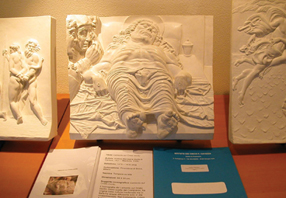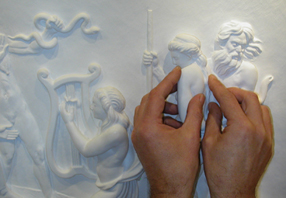|
Speaking about
Art by Loretta
Secchi The
evocative and fulfilling function of
words. |
|
"We
seem to always need to excuse ourselves for speaking about art. But there
are many important reasons for not stopping. All arts live off words», wrote Paul Valéry in one of his essays
in 1920, and from that statement we propose the
idea of the use of words as
an aesthetic equivalent capable of translating in words a
work of art. Ekphrasis is a literary description of or
commentary on a visual work of art, as Umberto Eco explains in a recent
essay entitled To
almost say the same thing. A few months ago, the Istituto
Francesco Cavazza launched Radio Oltre, its
schedule can be looked up at the following address: www.cavazza.it (in
Italian only). The cultural programming of the radio broadcasting will
include a cycle of 15 lessons on art history, focused on the
iconographic and iconological interpretation of paintings, described according to its
values of form, style and content. The works of art were selected because
they are renowned and also because of their placing in Bolognese museums,
as well as their presence in tridimensional translation at
the Tactile Museum Anteros. Historically introduced and than described
through the reconstruction of their genesis, meaning and relations to
assignors, as well as its cultural context, the paintings will
be the object of discussions together with the poetry and biography of the author.
This
initiative focuses on the
narration of the aesthetic values of a
work of art, materialized in the mind, with "eyes closed". The evocative
and fulfilling function of words, in substitution of visual and tactile
perceptions, represents a possibility for intellectual and imaginative
knowledge which must not take away the pleasure and the cognitive value of
sensory, optical and tactile perceptions. Rather, it can emphasize the importance
of the relation between
images and content, form and substance of a work
of art intended as a reflection of the spirit of
an era and of a culture. The imaginative process through which we reconstruct a painting, in its
iconic nature, always needs to create space in the mind and in feelings,
at the connection of knowledge, the relation between sensory memory and
mental representation. The
aesthetic experience begins when emotion and reason meet, from which
derives an intellectual
achievement stemming from the disposition of our soul in the moment in
which we learn a content and reinterpret it. |
That is, but not
only that, the power of imagination, which
is never a sterile supposition or auto-referential fantasy. On the contrary, it is nourished from the
contact and research of common denominators between collective and
individual thought, supported by the
experience. This therefore voids the separation between subject and
object, and brings both to the uniqueness of understanding true works of
art, since it is between
thought and art, between spirit and matter. There is an
authentic closeness. The
convergence of the strengths produced by imagination
confirms the translation of the visual representation in words and grants
symbiosis between intellective vision and sensitive perceptions.
It is also necessary to
acquire a methodological competence to evaluate the
use of the theory of art and
the critical tools
necessary to mature
the
autonomy of judgment. The precise description, though technical, is the
narration of the poetry of
an artist, of the feeling of the forms endowed with aesthetic value. When
speaking about works of art,
it is appropriate to
associate the history to the thought of
a period, presenting its content in contemporary terms. In a fresco by Giotto where the subject
is the figure of Christ or in the narration of Neoplatonic mythography,
with a connection between arts, literature, history, philosophy, we can
retrace the forms of the being,
then the categories through which we define joy, pain, beauty, ugliness, storms of the
soul and quietness. Feelings perspire in
works of art and are often described with great sensitivity
by mythological subjects.
So, through the knowledge of iconography, we become aware of something
that belongs to us in the pain of a mother for the death of her child, in
the fragility or the severity of a portrait, in the poetry of a landscape,
in the delightful beauty of a goddess or in the truth that is concealed in
a myth. Concentrating on the evocative and fulfilling function of words
does not mean to elude the irreplaceable value of sensitive visual
perception, but to recognize the vicarious and complementary function of
the senses. The
listening experience of words corresponding to vision teaches most of all the understanding of
what finds the best representation in the use of the metaphor, though
remaining invisible, respecting the code of shared
representation. |
Book about
tactile works of art
Tactile reading
of a relief in chalk |

